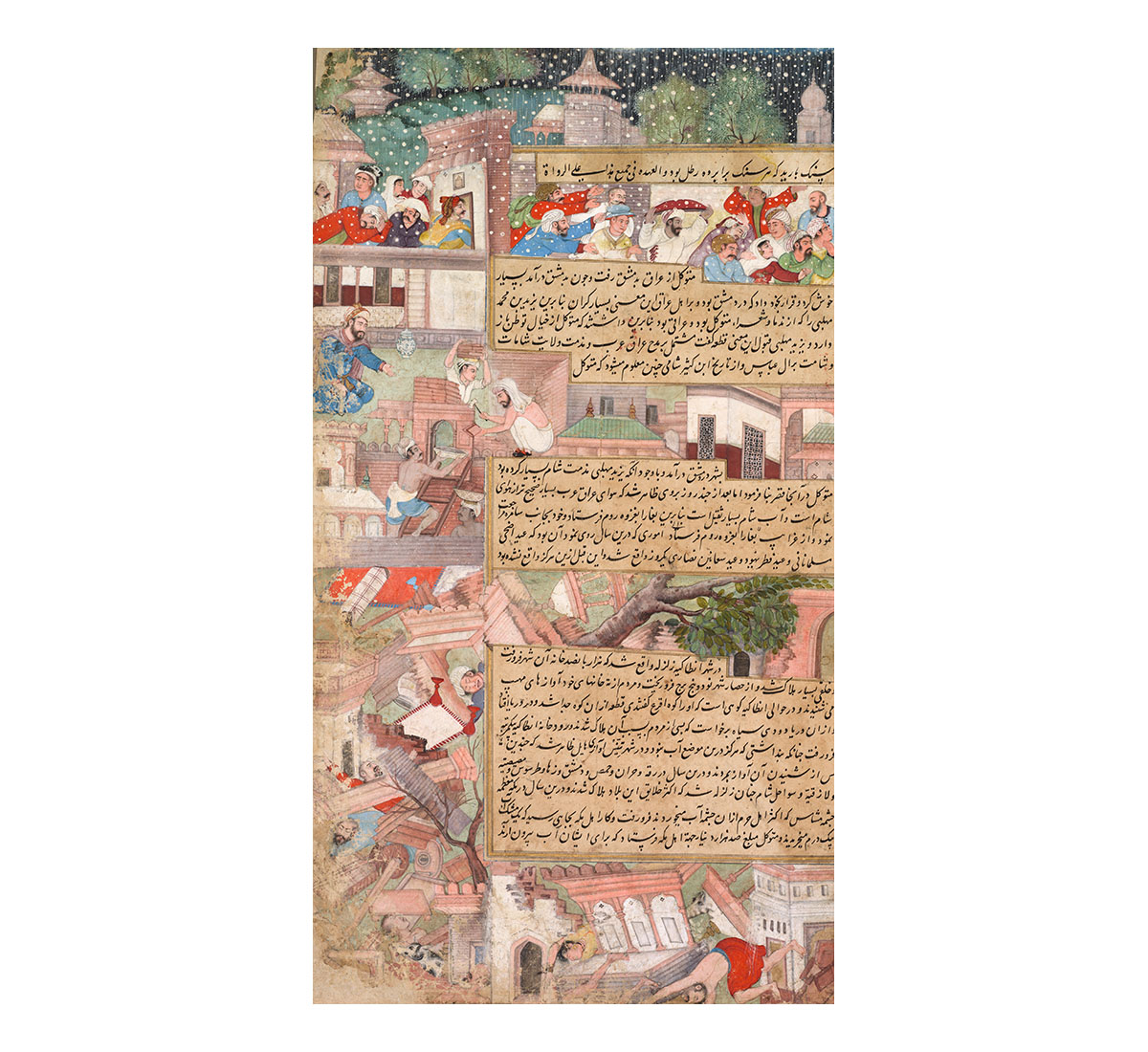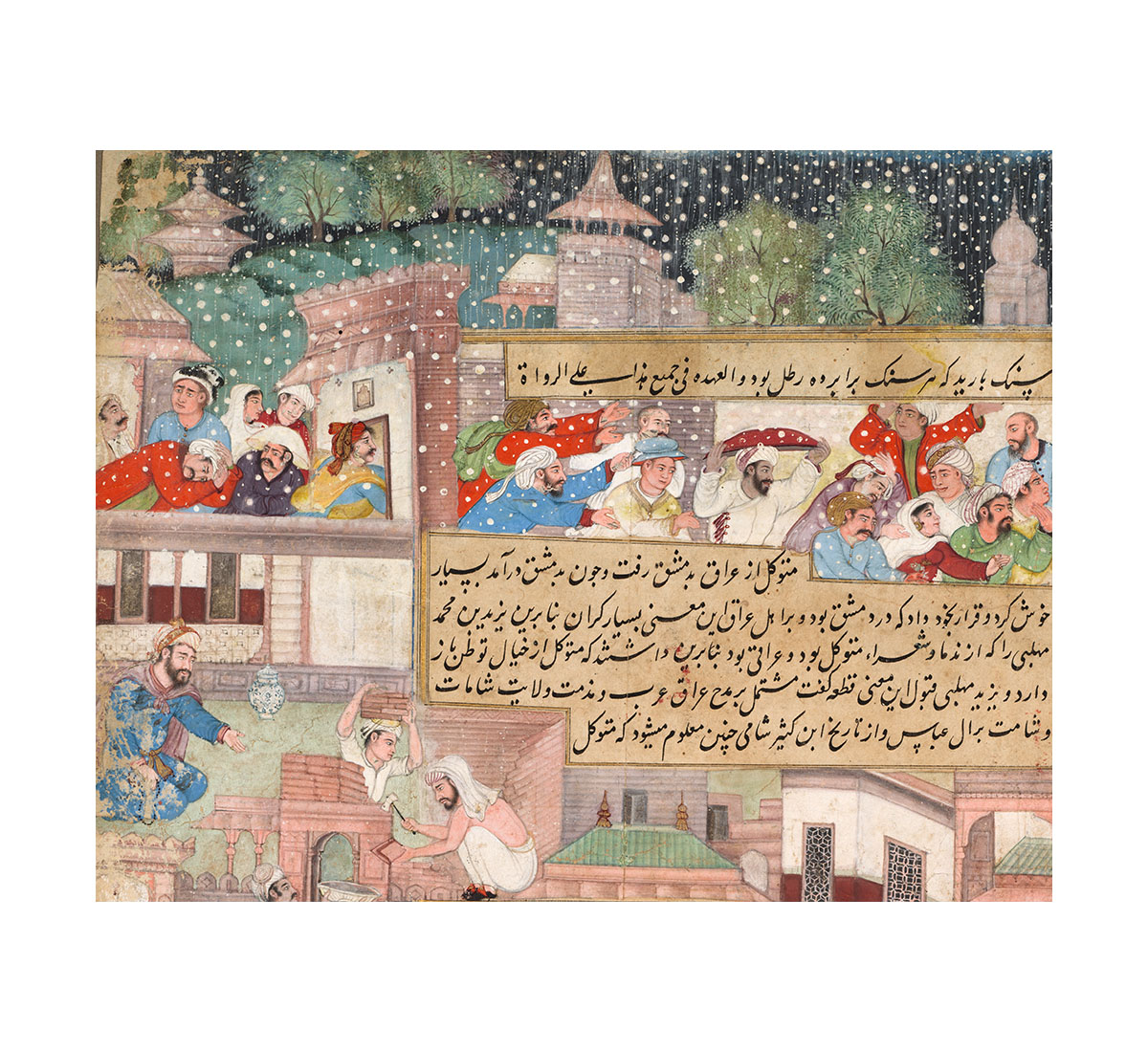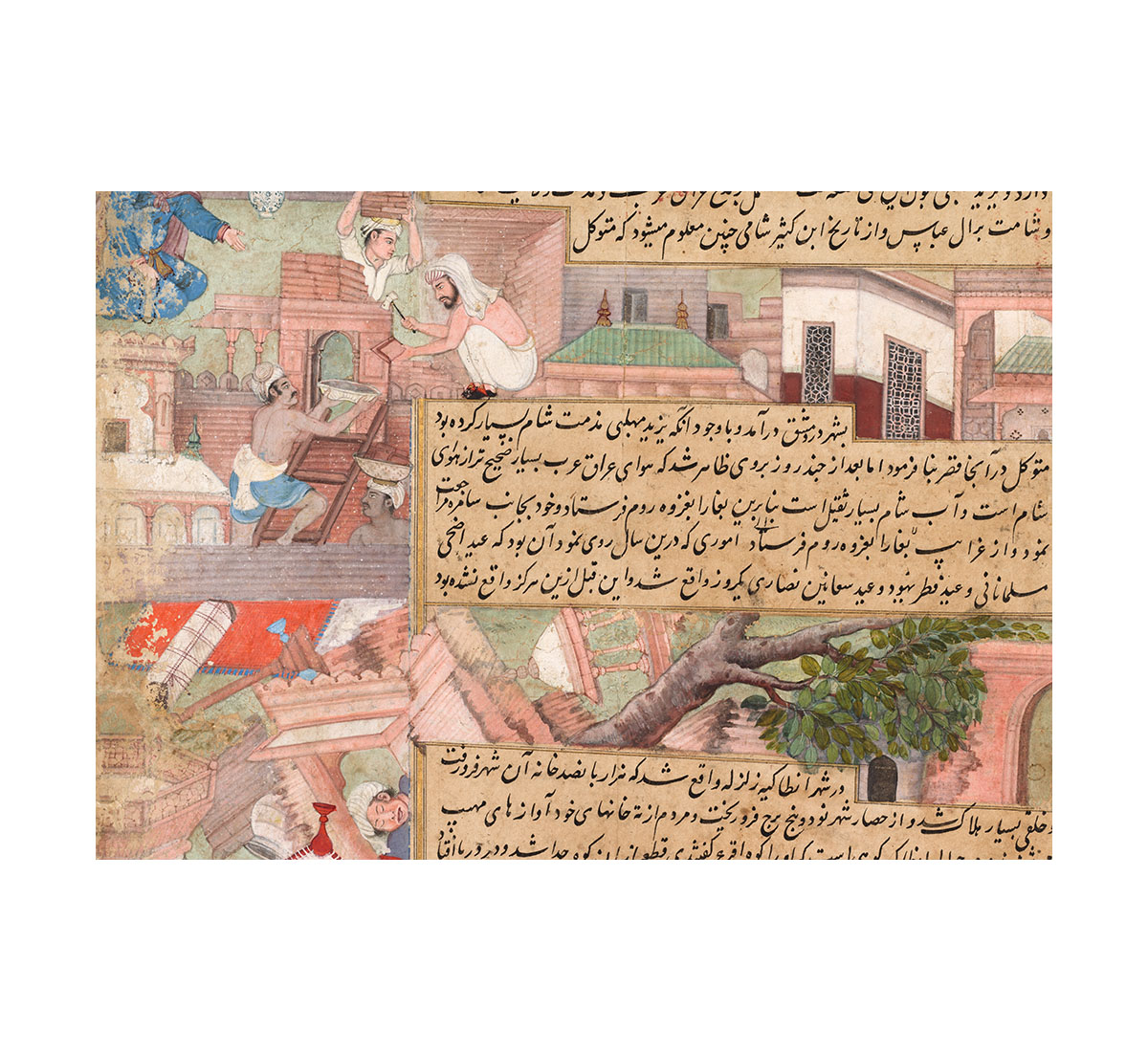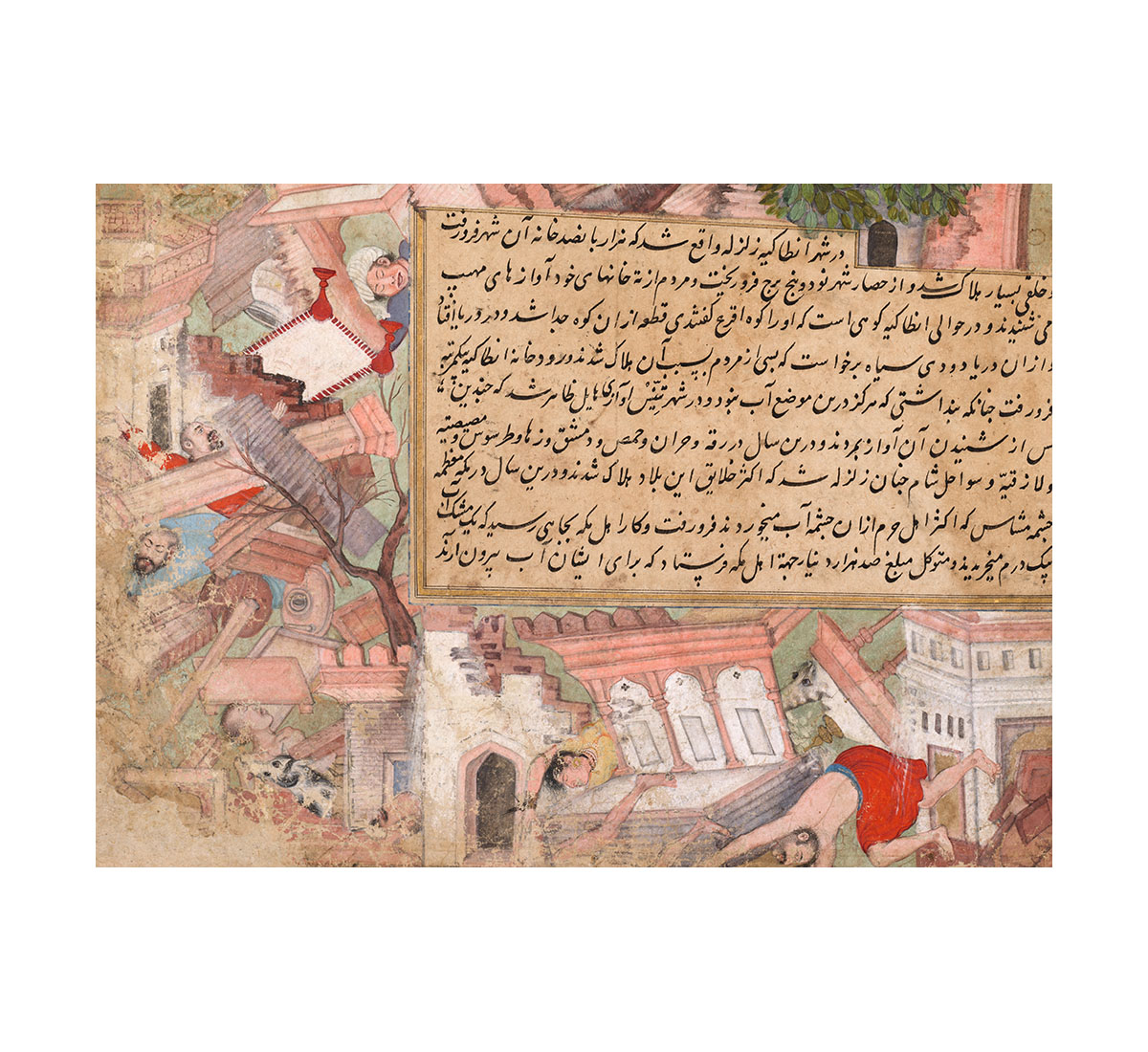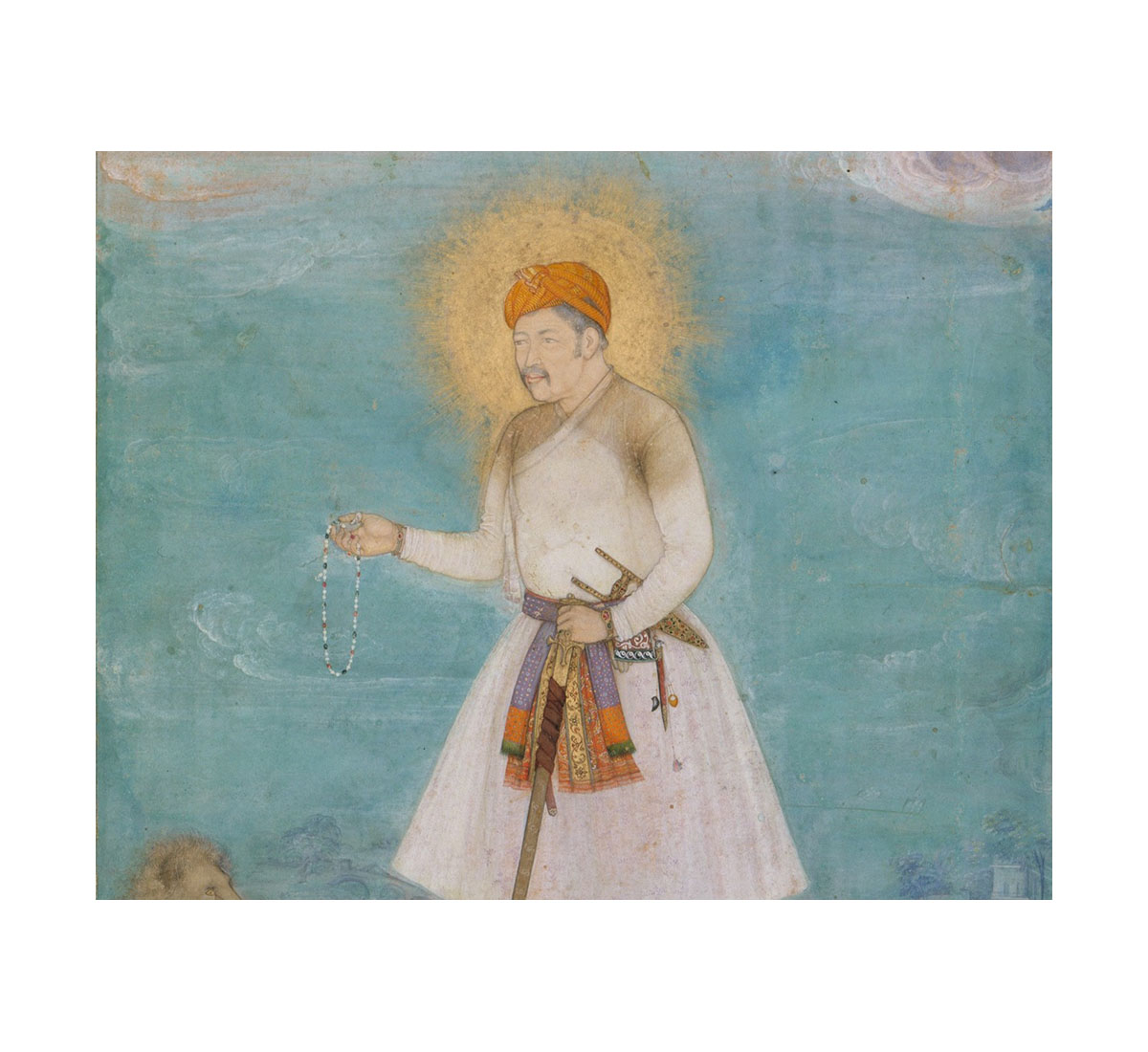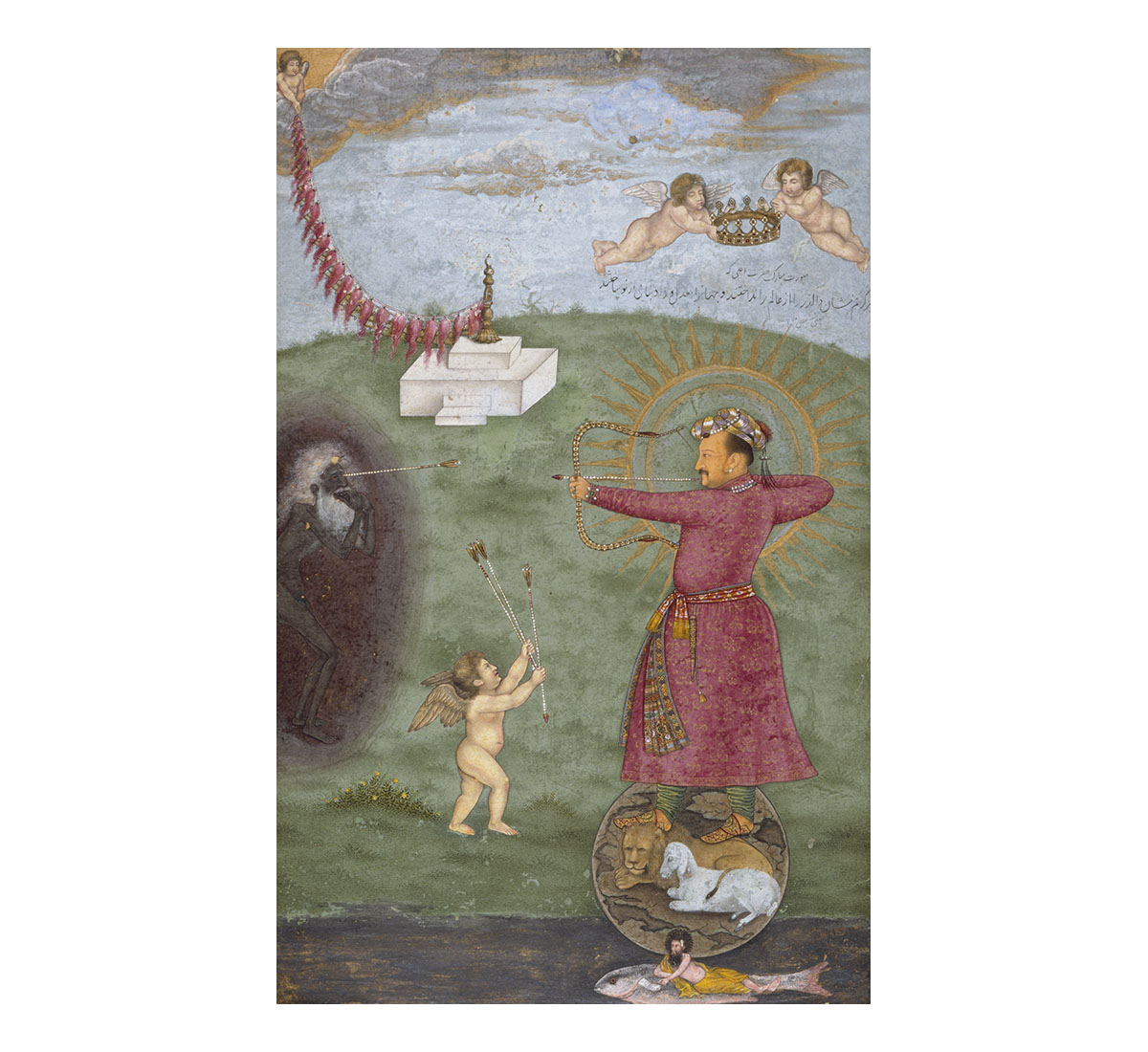PERSPECTIVES
Tarikh-i-Alfi: Creating the Image of an Ideal King
People flee as icy hail falls from the skies; a nobleman supervises the construction of a palace, only for it to be shaken to pieces by a disastrous earthquake. Animals, trees and people are crushed by collapsing architecture. Both this vision of disaster and the calligraphy that it enframes are part of a complex series of events and arguments collected in a volume known as the Tarikh-i Alfi, The History of One Thousand Years. Completed in 1592 CE, the year 1000 in the Islamic calendar, the Tarikh was commissioned by the Mughal emperor Akbar and developed by a team of Indian and Iranian scholars and artists in the employ of his court. It was, among other things, a response to the belief that the Islamic year 1000 was the beginning of a new cycle of time, the last before the end of the world; a holy saviour or saint-king was expected to appear and usher in a new earthly order. Akbar’s contemporaries, such as the Safavid Shah Ismail I and Muhammad Quli Qutb Shah of Golconda, had claimed this mantle before, and the Tarikh constitutes his attempt to do the same.
The Tarikh is by no means a comprehensive history, or even — strictly speaking — a history in the modern sense. It instead develops a theory of just and pluralistic kingship. It argues for the concentration of authority in the hands of a single enlightened ruler, reducing the power of the clergy, and providing a historical justification for Akbar’s pluralistic policies. The disasters depicted in this manuscript page are an example of how the Tarikh does so. The text describes a series of events from the ninth century, the third century of the Islamic calendar, when the Abbasid Caliph Al-Mutawakkil, known for his persecution of Zoroastrians, Jews and Christians, was in power. During his reign, Egypt faced deadly hailstorms, and Syria was hit by earthquakes that sent tremors as far as Iraq and destroyed multiple cities. These disasters, the Tarikh suggests, were a consequence of the Caliph’s religious intolerance, for such bigotry was a violation of the sacred duties of Islamic kingship.
To understand why the Tarikh makes this argument, we need to understand the political context within which it was produced. Just a few years before it was commissioned, Akbar had defeated a rebellion of his Central Asian lords, mostly Sunni Muslims. Around the same time, the Safavid dynasty of Iran had persecuted unorthodox Shia sects, and many of these Shia scholars and administrators had joined Akbar. Finally, Akbar had married a number of Hindu Rajput princesses and included their fathers and brothers in his military and court. Many of these actions were met with resistance from the Sunni clergy of northern India, and Akbar felt the need to formulate an intellectual rebuttal that justified his actions, exalted his authority and rulership, and explained the ambitions and antecedents of the empire that he was building.
The Tarikh was thus one among a series of projects undertaken by Akbar to establish himself as the culmination of a thousand years of history: the ‘ideal’ man and king. It situates Akbar at the pinnacle of a millennium during which Islam had transformed and evolved into one of the world’s most diverse and influential religions. It carefully curates a series of events and rulers from across West, Central and South Asia to create a new Mughal history of the world, and to justify Akbar’s belief that he was the prophesied millennial sovereign. Caliphs such as Al-Mamun, known for their patronage of literature and the sciences, appear; so do others known for intolerance, such as the aforementioned Al-Mutawakkil, so as to suggest that religious persecution was against the order of nature itself. The fifteenth-century Sultan of Kashmir, Zain-ul Abdin, is praised for his patronage of Brahmins and support of Hindu scriptures and sacred sites, providing South Asian precedents for Akbar’s policies. The Mughals, Ottomans and Safavids are all presented as highly cultured and tolerant Muslim kings, each ruling over their own part of the world. Scholars suggest that this is the earliest formulation of “imperial Hindustan” as a single identity stretching from the Himalayas through the Deccan into the deep South. Significantly, Central Asian rulers — especially Uzbeks — are marginalised in the text, suggesting that Akbar was seeking to actively sideline these unruly nobles in order to better integrate local warlords such as the Rajputs.
The Tarikh-i Alfi is thus not merely a historical chronicle. While it is certainly a response to the particular political conditions of the late sixteenth century, its conception of millennial, saintly sovereignty; its emphasis on tolerance and pluralism as integral to Mughal kingship; and its articulation of South Asia as a Mughal sphere of influence would go on to become fundamental to the empire’s sense of itself.
Bibliography
Anooshahr, Ali. “Dialogism and Territoriality in a Mughal History of the Islamic Millennium.” Journal of the Economic and Social History of the Orient 55, no. 2/3 (2012): 220–54. http://www.jstor.org/stable/41725620.
Beach, Milo Cleveland. “The Mughal Painter Abu’l Hasan and Some English Sources for His Style.” The Journal of the Walters Art Gallery 38 (1980): 6–33.
Chandra, Satish. “Standard of Living: Mughal India.” in The Cambridge Economic History of India, Volume I: c. 1200-c. 1750, edited by Tapan Raychaudhari and Irfan Habib, 458–470. Cambridge: Cambridge University Press, 1982.
Husaini, Said Reza. “The First Islamic Millennium and the Making of the Tarikh I Alfi in the Sixteenth Century Mughal India.” MA Thesis, University of Leiden, 2017. https://studenttheses.universiteitleiden.nl/handle/1887/52127.
Koch, Ebba. “Being Like Jesus and Mary: The Jesuits, the Polyglot Bible and Other Antwerp Print Works at the Mughal Court.” In Transcultural Imaginations of the Sacred, edited by Margit Kern and Klaus Krüger, 197–230. Berlin: William Fink Verlag, 2019.
Koch, Ebba. “Jahangir as Publius Scipio Maior: The Commensurability of Mughal Political Portraiture”. In Crispin Branfoot (ed.) Portraiture in South Asia Since the Mughals: Art, Representation and History, 73–90. London: I.B. Tauris & Co., 2018.
Koch, Ebba. “The Mughal Emperor as Solomon, Majnun, and Orpheus, or the Album as a Think Tank for Allegory”, Muqarnas Online 27, no. 1 (2010): 277–311.
Markel, Stephen, “The Enigmatic Image: Curious Subjects in Indian Art”, AsianArt.com. Accessed July 6, 2021. http://asianart.com/articles/enigmatic.
Matthee, Rudi, and Hiroyuki Mashita, “KANDAHAR iv. From The Mongol Invasion Through the Safavid Era,” Encyclopædia Iranica. Accessed May 7, 2024. http://www.iranicaonline.org/articles/kandahar-from-the-mongol-invasion through-the-safavid-era.
Pelsaert, Francisco. Jahangir’s India: The Remonstrantie of Francisco Pelsaert. Translated by W.H. Moreland and P. Geyl. Cambridge: W. Heffer & Sons, 1925.
van Putten, Jasper C. “Jahangir Heroically Triumphing Over Poverty: Pictorial Sources and Pictorial Tradition in Mughal Allegory and Portraiture.” In The Meeting Place of British Middle East Studies: Emerging Scholars, Emergent Research & Approaches, edited by Refqa Abu-Remaileh and Amanda Phillips, 99–118. Newcastle upon Tyne: Cambridge Scholars Publishing, 2009.
Ramaswamy, Sumathi. “Conceit of the Globe in Mughal Visual Practice.” Comparative Studies in Society and History 49, no. 4 (2007): 751–82.
Seyller, John. “Workshop and Patron in Mughal India: The Freer Rāmāyaṇa and Other Illustrated Manuscripts of ‘Abd Al-Raḥīm.” Artibus Asiae 42 (1999): 3–34.




